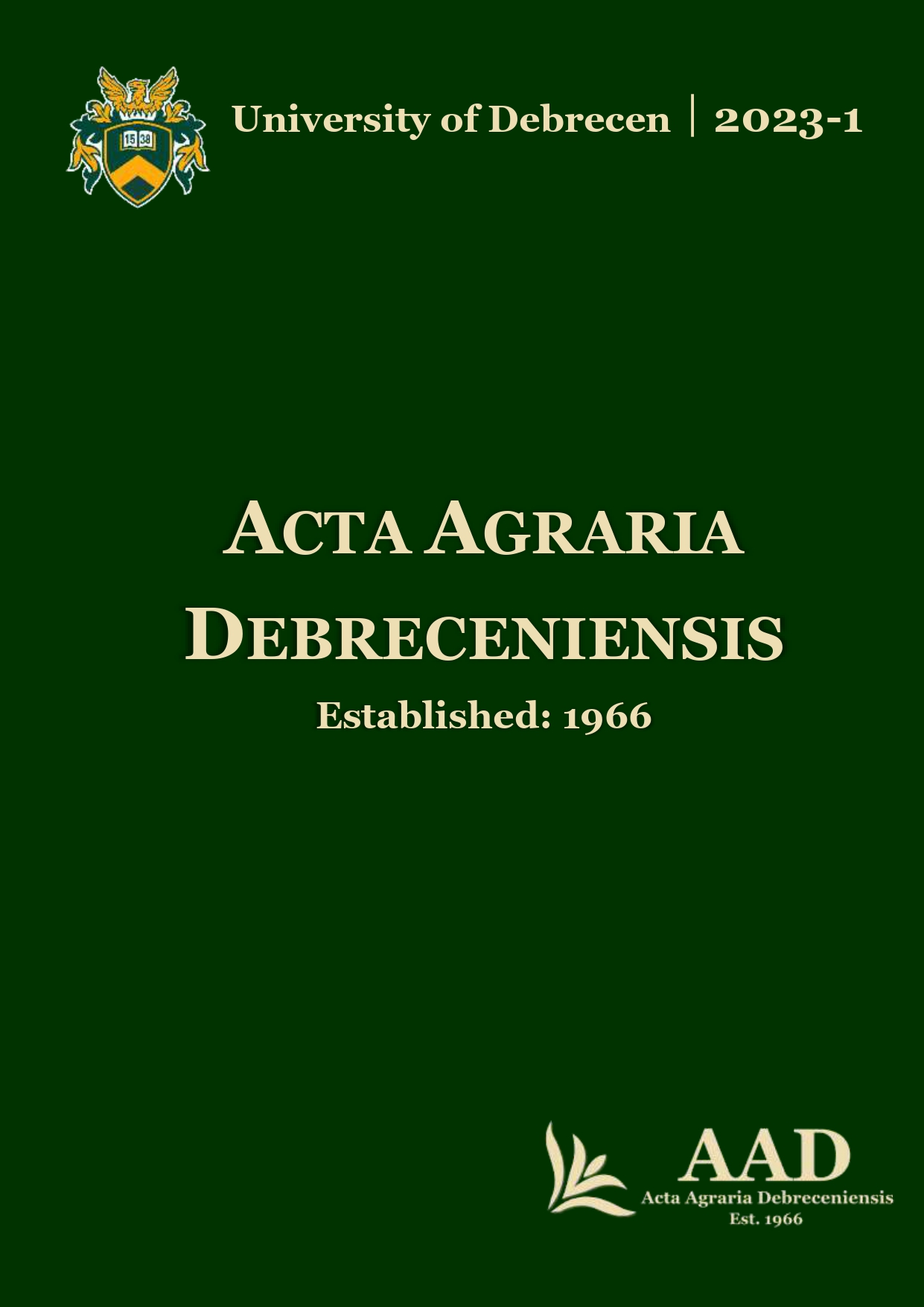Recovery and confirmation of Haemonchus contortus from abomasal contents of roe deer (Capreolus capreolus) in Eastern-Hungary (Biharugra): A diagnostic case study
Authors
View
Keywords
License
Copyright (c) 2023 by the Author(s)

This work is licensed under a Creative Commons Attribution 4.0 International License.
How To Cite
Accepted 2023-01-23
Published 2023-06-05
Abstract
Gastrointestinal parasites are ubiquitous. They occur both in wild and domesticated animals. Among such parasites of veterinary importance is the trichostrongyle worms, out of which the Haemonchus contortus species is regarded as the most pathogenic one in the small ruminant industry. The occurrence of this parasite in the sheep flock is now very well documented and an established fact in Europe, although the parasite was original of the warmer climatic region. Studies on the cross-transmission of H. contortus between the wild and domesticated animals are also on the rise although the question of the direction of transmission is still debated. This is an important area that needs to be addressed as it could potentially contribute indirectly to mitigating anthelmintic resistance. Hungary also has reported its share of the occurrence of the parasite, mainly in the sheep flock and a certain population of roe deer. The study presented here is the preliminary results of a diagnostic case study that confirms the presence of H. contortus in wild ruminant deer species that are close to the domesticated sheep population.
References
- Beaumelle, C.–Redman, E.–Verheyden, H.–Jacquiet, P.–Bégoc, N.–Veyssière, F.–Benabed, S.–Cargnelutti, B.–Lourtet, B.–Poirel, M. T.–de Rijke, J.–Yannic, G.–Gilleard, J.S.–Bourgoin, G. (2022): Generalist nematodes dominate the nemabiome of roe deer in sympatry with sheep at a regional level. International Journal for Parasitology. https://doi.org/10.1016/j.ijpara.2022.07.005
- Besier, R.B.–Kahn, L.P.–Sargison, N.D.–Van Wyk, J.A. (2016): The Pathophysiology, Ecology and Epidemiology of Haemonchus contortus Infection in Small Ruminants. Advances in Parasitology, 93, 95–143. https://doi.org/10.1016/bs.apar.2016.02.022
- Bolukbas, C.S.–Gurler, A.T.–Beyhan, Y.E.–Acici, M.–Umur, S. (2012): Helminths of roe deer (Capreolus capreolus) in the Middle Black Sea Region of Turkey. Parasitology International, 61(4), 729–730. https://doi.org/10.1016/j.parint.2012.06.008
- Chintoan-Uta, C.–Morgan, E.R.–Skuce, P.J.–Coles, G.C. (2014): Wild deer as potential vectors of anthelmintic-resistant abomasal nematodes between cattle and sheep farms. Proceedings of the Royal Society B: Biological Sciences, 281(1780), 20132985. https://doi.org/10.1098/rspb.2013.2985
- Clark, C.H.–Kiesel, G.K.–Goby, C.H. (1962): Measurements of blood loss caused by Haemonchus contortus infection in sheep. American Journal of Veterinary Research, 23(96), 977–980.
- Csivincsik, Á.–Nagy, G.–Halász, T.–Zsolnai, A. (2017): Shared pastures and anthelmintic resistance in wildlife and livestock. Agriculturae Conspectus Scientificus, 82(2 Special Issue 1), 189–191.
- Halvarsson, P.–Baltrušis, P.–Kjellander, P.–Höglund, J. (2022): Parasitic strongyle nemabiome communities in wild ruminants in Sweden. Parasites and Vectors, 15(1), 1–15. https://doi.org/10.1186/s13071-022-05449-7
- Hoberg, E.P.–Lichtenfels, J.R.–Gibbons, L. (2004): Phylogeny for species of Haemonchus (Nematoda: Trichostrongyloidea): Considerations of their evolutionary history and global biogeography among Camelidae and Pecora (Artiodactyla). Journal of Parasitology, 90(5), 1085–1102. https://doi.org/10.1645/GE-3309
- Kuzmina, T.–Kharchenko, V.–Malega, A. (2010): Helminth fauna of roe deer (Capreolus Capreolus) in Ukraine: Biodiversity and parasite community. Vestnik Zoologii, 44(1), 15–22. https://doi.org/10.2478/v10058-010-0002-1
- Laca Megyesi, Š.–Königová, A.–Babják, M.–Molnár, L.–Rajský, M.–Szestáková, E.–Major, P., Soroka, J.–Urda Dolinská, M.–Komáromyová, M.–Várady, M. (2020): Wild ruminants as a potential risk factor for transmission of drug resistance in the abomasal nematode Haemonchus contortus. European Journal of Wildlife Research, 66(1), 1–6. https://doi.org/10.1007/s10344-019-1351-x
- Le Jambre, L. F. (1995): Relationship of blood loss to worm numbers, biomass and egg production in Haemonchus infected sheep. International Journal for Parasitology, 25(3), 269–273. https://doi.org/10.1016/0020-7519(94)00118-8
- Lehrter, V.–Jouet, D.–Liénard, E.–Decors, A.–Patrelle, C. (2016): Ashworthius sidemi Schulz, 1933 and Haemonchus contortus (Rudolphi, 1803) in cervids in France: integrative approach for species identification. Infection, Genetics and Evolution, 46, 94–101. https://doi.org/10.1016/j.meegid.2016.10.027
- McGhee, M.B.–Nettles, V.F.–Rollor, E.A.–Prestwood, A.K.–Davidson, W.R. (1981): Studies on cross-transmission and pathogenicity of Haemonchus contortus in white-tailed deer, domestic cattle and sheep. Journal of Wildlife Diseases, 17(3), 353–364. https://doi.org/10.7589/0090-3558-17.3.353
- Nagy, G.–Csivincsik, Á.–Sugár, L.–Zsolnai, A. (2017): Benzimidazole resistance within red deer, roe deer and sheep populations within a joint habitat in Hungary. Small Ruminant Research, 149, 172–175. https://doi.org/10.1016/j.smallrumres.2017.02.012
- Nagy, G.–Csivincsik, Á.–Zsolnai, A.–Sugár, L. (2016): Benzimidazole resistance in Haemonchus contortus recovered from farmed red deer. Parasitology Research, 115(9), 3643–3647. https://doi.org/10.1007/s00436-016-5155-6
- Nagy, J.G.–Bencze, L. (1973): Game management, administration and harvest in Hungary. Wildlife Society Bulletin, 1(3), 121–127. http://www.jstor.org/stable/3781335
- Nilsson, O. (1971): The inter-relationship of endo-parasites in wild cervids (Capreolus capreolus L. and Alces alces L.) and domestic ruminants in Sweden. Acta Veterinaria Scandinavica, 12(1), 36–68.
- Pilarczyk, B.–Cisek, A.–Balicka-Ramisz, A.–Ramisz, A. (2016): Occurrence of gastro-intestinal nematodes in cervids (Cervidae) of North-Western Poland Issue 2 Series Animal Husbandry Occurrence of Gastro-Intestinal Nematodes In Cervids (Cervidae) of North-Western Poland. Elec JP Agric Univ, 6(2). http://www.ejpau.media.pl
- Redman, E.–Packard, E.–Grillo, V.–Smith, J.–Jackson, F.–Gilleard, J.S. (2008): Microsatellite analysis reveals marked genetic differentiation between Haemonchus contortus laboratory isolates and provides a rapid system of genetic fingerprinting. International Journal for Parasitology, 38(1), 111–122.
- Shen, D.D.–Wang, J.F.–Zhang, D.Y.–Peng, Z.W.–Yang, T.Y.–Wang, Z.D.–Bowman, D.D.–Hou, Z.J.–Liu, Z.S. (2017): Genetic diversity of Haemonchus contortus isolated from sympatric wild blue sheep (Pseudois nayaur) and sheep in Helan Mountains, China. Parasites and Vectors, 10(1), 1–10. https://doi.org/10.1186/s13071-017-2377-0
- Sutherland, I.–Scott, I. (2010): Gastrointestinal nematodes of sheep and cattle: biology and control. Wiley-Blackwell.
- Taylor, M.A.–Coop, R.L.–Wall, R.L. (2015): Veterinary parasitology. John Wiley & Sons.
- Waller, P.J.–Chandrawathani, P. (2005): Haemonchus contortus: parasite problem No. 1 from tropics-Polar Circle. Problems and prospects for control based on epidemiology. Trop Biomed, 22(2), 131–137.

 https://doi.org/10.34101/actaagrar/1/12058
https://doi.org/10.34101/actaagrar/1/12058